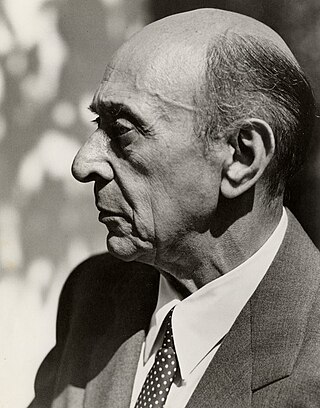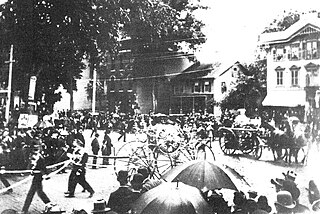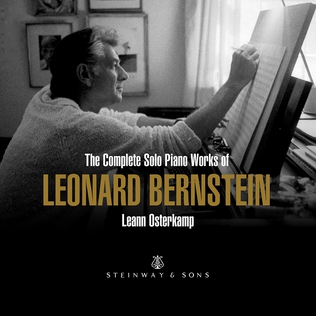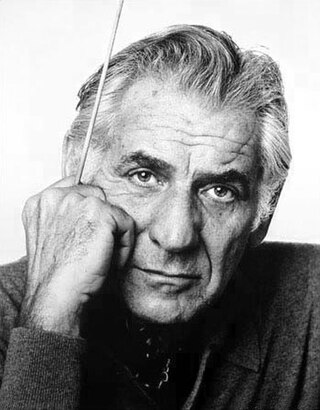Related Research Articles

The Turangalîla-Symphonie is the only symphony by Olivier Messiaen (1908–1992). It was written for an orchestra of large forces from 1946 to 1948 on a commission by Serge Koussevitzky for the Boston Symphony Orchestra. Along with the Quatuor pour la fin du temps, the symphony is one of the composer's most notable works.

Bösendorfer is an Austrian piano manufacturer and, since 2008, a wholly owned subsidiary of Yamaha Corporation. Bösendorfer is unusual in that it produces 97- and 92-key models in addition to instruments with standard 88-key keyboards.

Jake Heggie is an American composer of opera, vocal, orchestral, and chamber music. He is best known for his operas and art songs as well as for his collaborations with internationally renowned performers and writers.
Abbey Henry Simon was an American concert pianist, teacher, and recording artist. He was a protégé of Josef Hofmann at the Curtis Institute of Music and a winner of the Naumburg International Piano Competition in 1940. He was called a "supervirtuoso" by The New York Times.

Piano Concerto No. 2 in F major, Op. 102, by Dmitri Shostakovich was composed in 1957 for the 19th birthday of his son Maxim, who premiered the piece during his graduation concert at the Moscow Conservatory. It contains many similar elements to Shostakovich's Concertino for Two Pianos: both works were written to be accessible for developing young pianists. It is an uncharacteristically cheerful piece, much more so than most of Shostakovich's works.

Alexander Frey, KM, KStJ, is an American symphony orchestra conductor, virtuoso organist, pianist, harpsichordist and composer. Frey is in great demand as one of the world's most versatile conductors, and enjoys success in the concert hall and opera house, and in the music of Broadway and Hollywood. Leonard Bernstein referred to him as "a wonderful spirit".

The Wind Quintet, Op. 26, is a chamber music composition by Arnold Schoenberg, composed in 1923–24. It is one of the earliest of Schoenberg's compositions to use twelve-tone technique.
Quatre Études de rythme is a set of four piano compositions by Olivier Messiaen, written in 1949 and 1950. A performance of them lasts between 15 and 20 minutes.

The Missa Brevis by Leonard Bernstein is a musical setting of parts of the mass ordinary in Latin for a mixed a cappella choir with countertenor solo and percussion. It is also Bernstein's last complete choral work, due to his death a year after its completion in 1989.

Hallowe'en, also initially entitled Allegro vivace: Hallowe'en, is a short composition for piano quintet by American composer Charles Ives. It was probably composed in 1907 and was part of Three Outdoor Scenes, a collection of pieces that also included Central Park in the Dark.

The Gong on the Hook and Ladder or Firemen's Parade on Main Street, normally shortened as The Gong on the Hook and Ladder and also initially entitled Allegro moderato, is a short composition by American composer Charles Ives.

"Hymn: Largo cantabile", S. 84/1, sometimes also referred to as "Largo cantabile: Hymn" and often shortened as "Hymn", is a composition by American composer Charles Ives written in 1904. Grouped in the suite A Set of Three Short Pieces, it is published and commonly performed as a standalone work.

Tone Roads No. 1 is a short composition for chamber ensemble by American composer Charles Ives. It was finished in 1911.
Music for the Dance No. 2 is a composition for piano by American composer Leonard Bernstein. It was finished in 1938.
Non troppo presto, sometimes alternatively entitled Music for the Dance No. 1, refers to an untitled composition for piano by American composer Leonard Bernstein, written in 1937.
The Piano Sonata, originally entitled Sonata for the Piano, is the only piano sonata by American composer Leonard Bernstein. An early work by the composer, it was finished in 1938.
Four Sabras is a short composition for solo piano by American composer Leonard Bernstein. Each Sabra refers to vignettes or portraits of different fictitious Israeli children.

Bridal Suite is a suite for two pianists by American composer Leonard Bernstein. Composed in 1960, it was written for Phyllis Newman's wedding with Adolph Green.

Divertimento, or Divertimento for Orchestra, is a suite of eight orchestral bagatelles by American composer Leonard Bernstein. Completed in 1980 and written to celebrate the centenary of the Boston Symphony Orchestra, it is well-known for featuring the notes B and C in most of its melodic material.
Opus Two is an American violin and piano chamber music ensemble featuring violinist William Terwilliger and pianist Andrew Cooperstock. They are known for their contributions to the violin-piano duo repertoire and their performances and recordings of original American music for violin and piano.
References
- 1 2 3 "Works | Works | Leonard Bernstein". leonardbernstein.com. Retrieved 13 January 2022.
- 1 2 Bernstein, Leonard (2010). Music for piano. [New York, NY]: Leonard Bernstein Music Publishing Company. ISBN 9781423475149.
- 1 2 3 Cooperstock, Andrew (2017). Liner notes of Bridge 9485A/B. New York: Bridge Records.
- ↑ Lee, Douglas A. (1988). "Review of American Piano Music". American Music. 6 (1): 118–119. doi:10.2307/3448361. ISSN 0734-4392 . Retrieved 14 January 2022.
- 1 2 Magrath, Jane (September–October 1988). "Bernstein's "Anniversaries" and Other Works for Solo Piano". The American Music Teacher. 38 (1): 16–21.
- 1 2 Laird, Paul R. (15 February 2018). Leonard Bernstein. Reaktion Books. ISBN 978-1-78023-951-4 . Retrieved 13 January 2022.
- 1 2 Shawn, Allen (30 September 2014). Leonard Bernstein: An American Musician. Yale University Press. ISBN 978-0-300-14428-4 . Retrieved 13 January 2022.
- ↑ Liner notes of Pro Arte Records #109. 1984.
- ↑ "Etcetera records". www.etcetera-records.com. Retrieved 13 January 2022.
- ↑ "BIS Records - Bernstein - Symphonic Dances". bis.se. Retrieved 13 January 2022.
- ↑ "Cala Records Limited". calarecords.com. Retrieved 13 January 2022.
- ↑ Liner notes of Koch International Classics No. 7426. Koch International Classics. 1999.
- ↑ "Shura Cherkassky - The Nimbus Recordings". www.wyastone.co.uk. Retrieved 13 January 2022.
- ↑ "Touches of Bernstein: The Complete Published Piano Music of Leonard Bernstein. Touches - Chorale, Eight Variations and Coda". www.centaurrecords.com. Retrieved 13 January 2022.
- ↑ Liner notes of Frame 345. Frame. 2004.
- ↑ Liner notes of Eroica Distribution 3223. Eroica Classical Recordings. 2005.
- ↑ "BERNSTEIN, L. / TAN, Dun: Piano Music (Touches and Traces) (Warren Lee) - 9.70252". www.naxos.com. Retrieved 13 January 2022.
- ↑ "Complete Solo Piano Works of Leonard Bernstein - Steinway & Sons". www.steinway.com. Retrieved 13 January 2022.
- ↑ "Leonard Bernstein: The Complete Music for Piano; Andrew Cooperstock, piano; BRIDGE 9485A/B". Bridge Records. Retrieved 13 January 2022.
- ↑ "BERNSTEIN Complete Piano Works / Mahan". www.deutschegrammophon.com. Retrieved 17 January 2022.
- ↑ "BERNSTEIN Complete Works". www.deutschegrammophon.com. Retrieved 17 January 2022.
- ↑ "MENDELSSOHN: Preludes and Fugues, Op. 35 (excs) | BEETHOVEN: Eroica Variations, Op. 35 | etc – First Hand Records – FHR" . Retrieved 13 January 2022.
- ↑ "Bernstein: Complete Solo Piano Music - Brilliant Classics". www.piano-classics.com (in Dutch). Retrieved 13 January 2022.